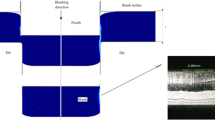Abstract
This paper proposes a novel approach to fine blanking. The V-ring indenter used in conventional fine blanking is no longer required; a trough on the die is used instead. In this approach, the cutting process combined with high hydrostatic stresses produced from the trough on the die cutting edge can substantially decrease the fracture in the shear zone. A series of experimental tests with experimental specimens of various thicknesses was conducted. The burnished surface obtained from this approach can nearly achieve the complete thickness of the blank in one operation, suggesting that the fracture zone can be nearly eliminated. In addition, the surface roughness of the burnished surface range was measured between 0.03 and 0.08 μm, and the tolerance band for the diameter was between IT2 and IT4. These results indicate an improvement in the values obtained using conventional fine blanking.
Similar content being viewed by others
References
Chang TM, Swift HW (1950) Shearing of metal bars. J Inst Met 78:119–146
Tilsley R, Howard F (1958) Recent investigations into the blanking and piercing of sheet materials. Machinery 93:151–158
Noble CF, Oxley PLB (1963) Crack formation in blanking and piercing. Int J Prod Res 2:265–274
Johnson W, Slater RAC (1967) A survey of the slow and fast blanking of metals at ambient and high temperatures, Proceedings of the International Conference of Manufacturing Technology, Michigan, pp. 773–851
Nakagawa T, Maeda T (1968) Experimental investigation on fine-blanking. Sci Pap 62:65–80
Johnson R, Fogg B, Chisholm AW (1968) An investigation into the fine-blanking process. In: Proceedings of the 9th International Machine Tool Design & Research Conference Birmingham, England, 397–410
Fukui S, Konda K, Maeda K (1971) Smooth shearing by stepped profile tool. Ann CIRP 20:57–58
Lange K (1978) The potential of the fine-blanking technique. Feintool AG Lyss, Switzerland, pp 1–6
Lee TC, Chan LC, Wu BJ (1995) Straining behaviour in blanking process-fine-blanking vs conventional blanking. J Mater Process Technol 48:105–111
Morreale J, Marchand JL, Ronde Oustau F (1992) Development of a numerical code based on the slip-line field method: application to the fine-blanking process. J Mater Process Technol 31:393–411
Kwak TS, Kim YJ, Seo MK, Bae WB (2003) The effect of V-ring indenter on the sheared surface in the fine-blanking process of pawl. J Mater Process Technol 143–144:656–661
Padmanabhan R, Oliveira MC, Alves JL, Menezes LF (2007) Influence of process parameters on the deep drawing of stainless steel. Finite Elem Anal Des 43:1062–1067
Thipprakmas S (2010) Application of Taguchi technique to investigation of geometry and position of V-ring indenter in fineblanking process. Mater Des 31:2496–2500
Elyasi M, Daeizadeh V (2011) Effect of shape of workpiece on forming force in fine-blanking process. Mater Res Innov 15:S386–S389
Masahiro S, Taiki T (2014) Measurement of rollover in double-sided shearing using image processing and influence of clearance. Procedia Eng 81:1139–1144
Slavič J, Bolka Š, Bratuš V, Boltežar M (2014) A novel laboratory blanking apparatus for the experimental identification of blanking parameters. J Mater Process Technol 214:507–513
Wang JP, Huang GM, Lee HD, Chen CC, Chen TT (2013) Optimization of fine hydro-blanking. Steel Res Int 84:777–783
Wang JP, Huang GM, Chen CC, Yea YC, Chen TT (2013) Investigation of the shear-zone length in fine hydromechanical blanking. Int J Adv Manuf Technol 68:2761–2769
Huang GM, Wang JP, Chen TT, Chen CL, Xu MH (2014) Optimal design for the fluid cavity shape in hydromechanical fine blanking. Int J Adv Manuf Technol. doi:10.1007/s00170-014-5746-2
Wang CP, Channel-form fine blanking device, Utility PATENT, No. M 479806, (2014-6-11~2023-11-4)
Author information
Authors and Affiliations
Corresponding author
Rights and permissions
About this article
Cite this article
Wang, JP. A novel fine-blanking approach. Int J Adv Manuf Technol 78, 1015–1019 (2015). https://doi.org/10.1007/s00170-014-6701-y
Received:
Accepted:
Published:
Issue Date:
DOI: https://doi.org/10.1007/s00170-014-6701-y




